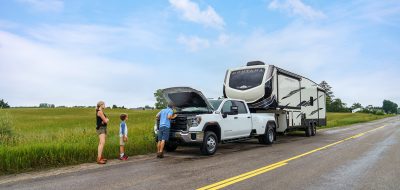Previously we’ve looked at four of the five ways you can assist your service shop. To recap, they are:
- Record All Identifying Numbers
- Organize a Repair History of the RV
- List All Add-on Components
- Look for the Obvious
Here in Part III we reveal the fifth and final way you can actually save repair dollars by assisting your service shop before they even begin work on your RV. The final tip is to:
5. Document the Exact Specifics of the Symptom
Of these five tips, this is probably the most valuable, however, this one takes a little more effort on your part. Ready? Whenever a symptom develops, begin to write down specific aspects that pertain to it. For instance, does the problem occur every time? Only at night? When the tank is full? Only after start-up? Only after shut-down? Only when it’s hot outside? Get the idea?
Also note any and all geographical attributes at the time of the occurrence; high elevation, near the beach, steep incline, hot and dusty, at the lake, desert, mountains, etc. Some symptoms may be peculiar to one of these areas that will help the tech pin-point the problem source, or at least narrow the scope of his search. Remember, these efforts are in your best interest.
Also note exact weather conditions at the time; windy, rainy, snowy, sunny, cloudy, dry, humid, air temperature, etc. These can all be applied to the mix when performing diagnostic procedures, especially on LP appliances and internal combustion engines. Can you duplicate the symptom now? Can you override or by-pass the problem? Is it intermittent or constant? By asking yourself these types of questions, the derived answers can be noted and given to the service writer. When compiled and translated by the service writer, then absorbed and applied by an astute technician, your input can greatly enhance the feasibility of spending the minimum amount of time in the service bay.
Additionally, use your product knowledge to further pin-point a possible cause. For instance; if you are experiencing a refrigerator problem, does the problem exist during both gas and electric operation? While driving or only while sitting still? Or both? Only during the heat of the day, or at night also? Document the specifics. The more information documented, the better the chances of getting back to that vacation sooner.By applying all five of these items, at the very least, your visit to the repair shop will be less stressful knowing you’ve contributed to the successful repair of your RV. You’ve done your part. During the course of your RVing season the additional time savings may also be substantial.
Oh, that theoretical scenario mentioned at the top of this article…. here’s what really happened. After realizing the generator would not start, the owner began an initial, cursory inspection, taking notes along the way while his wife phoned the service center. Here are the notes he handed to the service writer along with the brand, model and spec number of the generator.
- Generator – no start, does not even turn over
- Fuel tank, over 3/4 full, no fuel dripping anywhere
- Weather – mild, temp about 65 degrees, partially cloudy, no wind
- Level parking lot, standing still, leveling jacks engaged
- Tried to start at generator instead of dash switch – started right up and ran fine
- No burned or disconnected wires visible in generator compartment
- Tried dash switch again, no click, no nothing
- Total running hours: 27.3 – no previous repairs
The service writer read the list then decided to check two items before writing the repair order. First, he opened the generator compartment and checked the remote cable connector. It was clean and tight. Next, he reached behind the dash switch and there discovered a wire that had vibrated loose. He connected the wire, started, then stopped the generator with no further problem. He thanked the customer for stopping by, gave him a company business card and sent him back to his vacation – no charge.Because of the detailed set of notes, (which took the owner less than 20 minutes to compile), it was clear the problem was not even in the generator itself. Rather, the condition existed somewhere in the harness between the generator and the remote start switch located on the dash panel. If it had not been that loose wire, it may have been a cut or burned section in that harness under the motorhome somewhere, in which case, the service writer would have completed the repair order and sent the coach to the technician. Even then, because of the customer’s input, the tech would probably have found the cause in a minimum amount of time anyway.
This is not to proclaim that all service-related and technical problems will be eliminated completely, but one would be hard-pressed to deny that if these five steps are employed, there is indeed a greater chance of a faster turn-around in the shop, allowing you to spend more of your hard earned vacation time enjoying the RVing life-style.
Additional Tips
- Be prepared to provide more information than is really needed. The technician and service writer will sift through your input for the viable tidbits. Better to have too much info than to overlook something important.
- Always photocopy your notes and give them to the service writer at the time of the repair order write-up. As an attachment to the repair order, they will aid the technician during the troubleshooting process, however, don’t count on getting them back.
- Always print or type your notes. Do not force them to decipher your handwriting. Remember, the goal is to save time. Scrawled writing is difficult to read and may lead to confusion or mis-interpretation.
- Make yourself available to answer any questions the service writer or technician may have. Let the service writer know where you will be at all times while your coach is in the shop.




Pingback: 5 Ways to Assist the RV Service Facility - Part 2
Ron Wilkinson
Great information for the techs.